In 2016, the drug wars in Mexico claimed between 21,000 and 23,000 lives. That’s back to the peak levels of 2010 to 2012, when up to 23,000 people died each year in drug-related homicides. Between 2007 and 2017, a total of 177,000 people were murdered—but that may actually under-count, since many bodies are hidden in mass graves that may have never been found. Tens of thousands of people have also been internally displaced. In short, Mexico’s conflict is more intense than many civil wars and insurgencies around the world.
When Enrique Peña Nieto became president five years ago, he and the Mexican public sought to put the drug war behind them. Promising to cut down the murder rate by 50 percent in his first six months, he instead focused on Mexico’s badly needed energy, economic, and education reforms. He indeed succeeded at getting important measures passed, though implementation has been a challenge.
Meanwhile, although the drug market initially calmed in his first two years, the wars among Mexico’s criminal groups have been relentless. The violence has returned to areas where progress seemed to have been achieved—such as Tijuana and Cuidad Juárez—but continues to rage ferociously in Guerrero, Michoacán, and Tamaulipas, and spread to new areas, including Mexico’s center and south.
Multiple immediate and structural causes are driving the persistence and intensification of the criminal violence, including particularly cartel fragmentation and turf war on the one hand, and weak rule of law and problematic policy choices on the other.
Sinaloa’s Fragmentation
One of the precipitants of the re-intensified violence over the past two years has been the infighting within the Sinaloa Cartel following the recapture of Mexico’s most notorious drug trafficker Joaquín “El Chapo” Guzmán (it was his third arrest, after one in 1993 and a second in 2014). El Chapo was a master logistician, pioneering ways to smuggle drugs to the United States, such as by building tunnels underneath the border, and establishing wholesale distribution networks throughout the United States.
More importantly, far more than other leading drug traffickers in Mexico, he established leadership succession systems in the Sinaloa Cartel that allowed it to withstand decapitation policies of the Mexican government, which had been focusing on arresting or killing the heads of the cartels. That policy led to cartel fragmentations, as well as vicious infighting over turf among them and over leadership control within them.
But even after his second arrest in 2014, the post-Chapo leadership structures of the Sinaloa Cartel held together, a unique success among Mexican criminal groups. The Sinaloa Cartel had some breakoffs, such as the Beltrán Levya branch, but at its core held together better than any other cartel. El Chapo designated two leaders to run the Sinola Cartel, Ismael “El Mayo” Zambada, known for striking deals with rivals, making alliances, and seeking to avoid bloodbaths; and Dámaso López Núñez, alias El Licenciado. In picking Zambada and El Licenciado, El Chapo even passed over his children, rewarding experience over family. The succession arrangement held through El Chapo’s second imprisonment, his escape from a maximum-security prison through a tunnel late in 2014, and his hiding for the following year in January 2016 until he was recaptured again.
But the arrangement has collapsed since. El Mayo has apparently been ill, and his absence from day-to-day operations and strategic guidance significantly weakened the cartel. El Licenciado proved to be a problematic choice, turning on Chapo’s sons and causing a split in the group between Chapo’s family and other Sinaloa factions. El Licenciado was arrested in May 2017, but that alone may not calm the infighting. Moreover, widespread knowledge of the Sinaloa Cartel’s troubles has encouraged other criminal groups to attempt to take over some of Sinaloa’s hard-won turf in places such as Tijuana, Baja California, and Ciudad Juárez.
The New Aggressor on the Block
Mexico’s criminal groups differ in their expansionist ambitions and their systems of rule. While the Sinaloa Cartel has long sought to cultivate political capital among local populations by sponsoring churches and soccer stadiums, organizing social services, and throwing parties—as well as cultivating a robust network of corrupt politicians and law enforcement officials—other groups, such as the Zetas, rule through sheer brutality, seeking to outcompete others in violence and aggression. Consequently, they also burned out quickly.
Mexico’s criminal groups differ in their expansionist ambitions and their systems of rule.
Today, it is the Jalisco Nueva Generación Cartel (JNG) that is adopting the Zetas’ model. Like the Zetas, they are unleashing aggressive territorial wars, trying to push into locales where other criminal groups have established dominance—such as in Cuidad Juárez and Tijuana, where they are challenging the Sinaloa Cartel. But as JNG enters new areas, it has not learned to provide socio-economic goods and governance in order to build up political capital, even though some of its members are former Zetas who have witnessed the ineffectiveness and limitations of the group’s brutality-über-alles strategy. Jalisco Nueva Generación has also mimicked the Zetas’ aggressiveness against the Mexican state, choosing highly provocative strategies such as shooting down a military helicopter. Thus, like the Zetas before it, this new cartel is attracting violent opposition from all corners, further fueling the violence.
The law enforcement problem
The broader structural cause underlying the infighting, however, is the inability of Mexico’s law enforcement agencies to deter the violence. While El Chapo’s recapture triggered new infighting in Mexico, there have been no similar palpable ripple effects in the United States, even though the Sinaloa Cartel is widely assumed to control between 40 percent and 60 percent of the cocaine and heroin sold on U.S. streets. The cartel’s franchises in the United States have not slipped into infighting, nor have other Mexican criminal groups operating in the United States sought to violently take over its U.S. distribution, because U.S. law enforcement and justice systems have deterrence capacity to prevent violence among organized crime groups. By and large, drug peddling in the United States is peaceful, just as it is even less violent in Western Europe and East Asia.
But in Mexico, that deterrence capacity collapsed in the 1980s—in large part because criminal groups extensively infiltrated the highest levels of law enforcement, and because subsequent efforts at police reform were inadequate. Merely breaking up cartels neither establishes the rule of law, nor strengthens the state, nor creates deterrence capacity.
And the opportunistic high-value-targeting policy, although relatively easy to implement, only makes things worse because it constantly generates leadership succession struggles and encourages new turf wars. A different targeting pattern is needed: one that seeks to both generate stability in the criminal market and weaken criminal groups, as well as seeks to create deterrence by anticipating where violence may break out as a result of arrests.
Equally important, Mexico also finally needs to undertake serious local police reform, instead of getting tied up in knots for years over whether the local police will be rolled into state police or kept separate. Regardless of the design, what’s necessary is adequate police training standards and continual vetting, adequate salaries, permanent deployment of local police forces in sufficient density through Mexico’s territory, adequate and swift backup from state and federal police forces, and internal affairs units to whom municipal forces are subject, as well as the establishment of credible, non-corrupt, joint police-citizen oversight boards.
Supply, meet demand
Another driver of the escalating violence in Mexico is the rising taste in the United States for opiates, such as heroin, and the subsequent increase in opium poppy cultivation in Mexico. For decades, poppy has been cultivated in the state of Sinaloa, as well as in the poor and state-neglected tierra caliente in Michoacán and Guerrero. But the recent heroin boom and poppy expansion are driving new turf wars in those places, as smaller groups such as Las Viagras in Guerrero compete for territorial control and smuggling routes with large groups, such as JNG.
During their recent visit to Mexico, U.S. Secretary of State Rex Tillerson and Homeland Security Secretary John Kelly went to great lengths to emphasize that U.S. demand for drugs lies at the heart of Mexico’s violence problems, embracing the Bush and Obama administrations’ language of shared responsibility. They committed the United States to reducing demand for drugs, with Secretary Kelly going as far as to say (inaccurately) that “[w]e’ve never tried it” [i.e. tried to reduce demand], and accurately, that “we’ve never done it.”
Acknowledging responsibility and committing the United States to reduce demand is praiseworthy. It is certainly better than promoting aggressive eradication in Mexico, as the United States is also considering, in the absence of alternative livelihoods for poor farmers in there. Such eradication will only drive poppy farmers further into the hands of Mexican cartels and encourage greater violence; and it won’t curtail production in a lasting way.
But how the United States goes about reducing demand matters. Bringing hardcore addicts into treatment substantially reduces demand, since outside of treatment they consume 80 percent of drugs, with casual users consuming the rest. Mounting an abstinence campaign does little good, and imprisoning users causes tremendous social harm without cutting down use and demand. Yet in policy after policy the Trump administration is repeating the ineffective and counterproductive punishment route: increasing penalties, including incarceration, for users and non-violent dealers (which the Obama administration finally backed away from), repealing Obamacare provisions that enabled addicts to access medical treatment for their addiction as well as mental health problems, and slashing the budget of the Office on National Drug Policy Control which (with all of its problems and challenges) is a crucial source of data.
The reverse of all of these policies is needed; so is support for harm reduction approaches in the United States, such as naxalone availability to reverse overdose. Other policies proven to reduce use by addicts are crucial too, such as mild, swift, and certain punishments amounting to a night or a few days in prison, but no more.
The Brookings Institution is committed to quality, independence, and impact.
We are supported by a diverse array of funders. In line with our values and policies, each Brookings publication represents the sole views of its author(s).




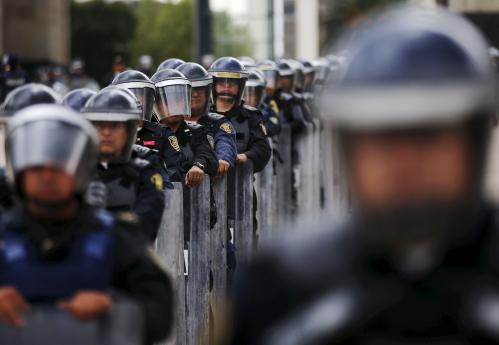
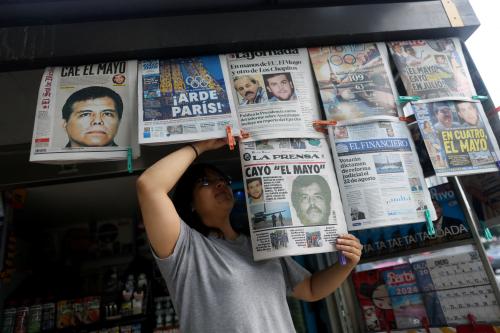
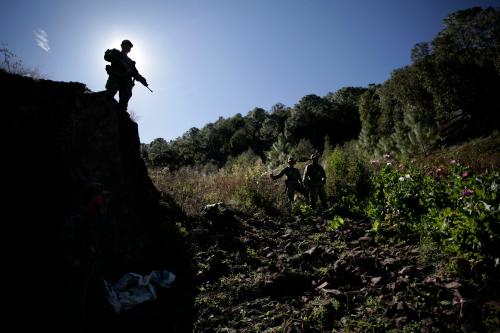

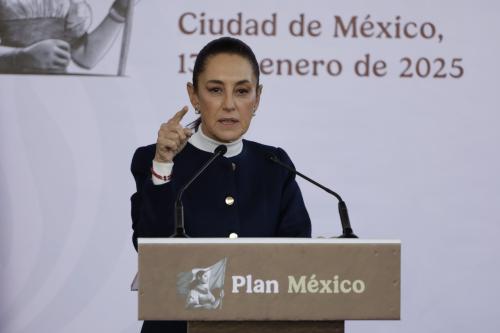
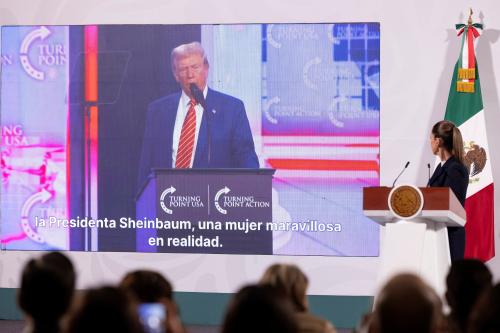
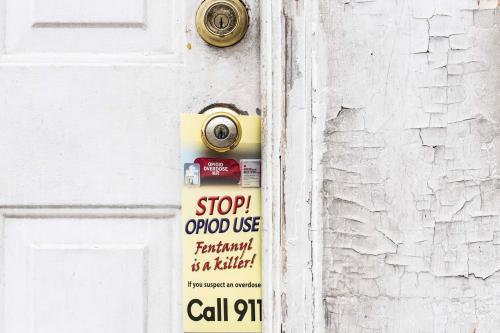
Commentary
Hooked: Mexico’s violence and U.S. demand for drugs
May 30, 2017